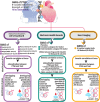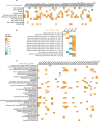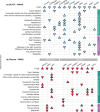Shared genetic architecture of posttraumatic stress disorder with cardiovascular imaging, risk, and diagnoses
- PMID: 40595462
- PMCID: PMC12217169
- DOI: 10.1038/s41467-025-60487-w
Shared genetic architecture of posttraumatic stress disorder with cardiovascular imaging, risk, and diagnoses
Abstract
Patients with post-traumatic stress disorder face increased cardiovascular risk. This study examines shared genetic regions between post-traumatic stress disorder and 246 cardiovascular conditions across electronic health records, 82 cardiac imaging, and health behaviors defined by Life's Essential 8. Post-traumatic stress disorder is genetically correlated with cardiovascular diagnoses in 33 regions, imaging traits in 4 regions, and health behaviors in 44 regions. Potentially shared causal variants between post-traumatic stress disorder and 17 cardiovascular conditions were observed in 11 regions. Subsequent observational analysis in AllofUS cohort showed post-traumatic stress disorder is associated with 13 diagnoses even after accounting for socioeconomic factors and depression. Genetically regulated proteome expression in brain and blood tissues identified 33 blood and 122 brain genes shared between the two conditions, revealing neuronal, immune, metabolic, and calcium-related mechanisms, with several genes as targets for existing drugs. These findings exhibit shared risk loci and genes are involved in tissue-specific mechanisms.
© 2025. The Author(s).
Conflict of interest statement
Competing interests: R.P. reports a research grant from Alkermes outside the scope of this study. R.P. and J.G. are paid for their editorial work on the journal Complex Psychiatry. J.G. is named as an inventor on PCT patent application no. 15/878,640 entitled “Genotype-guided dosing of opioid agonists”, filed January 24, 2018. M.B.S. has in the past 3 years received consulting income from Actelion, Acadia Pharmaceuticals, Aptinyx, atai Life Sciences, Boehringer Ingelheim, Bionomics, BioXcel Therapeutics, Clexio, Delix Pharmaceuticals, EmpowerPharm, Engrail Therapeutics, GW Pharmaceuticals, Janssen, Jazz Pharmaceuticals, and Roche/Genentech; has stock options in Oxeia Biopharmaceuticals and EpiVario; and has been paid for editorial work on Depression and Anxiety (Editor-in-Chief), Biological Psychiatry (Deputy Editor), and UpToDate (Co-Editor-in-Chief for Psychiatry). C.J.O an employee of Novartis Pharmaceuticals). D.K. is the founder and CEO of EndoCare Therapeutics, but the company conducts research unrelated to the present study. The other authors declare no competing interests.
Figures





References
-
- Vaduganathan, M., Mensah, G. A., Turco, J. V., Fuster, V. & Roth, G. A. The global burden of cardiovascular diseases and risk: a compass for future health. J. Am. Coll. Cardiol.80, 2361–2371 (2022). - PubMed
-
- Jacquet-Smailovic, M. et al. Relationship between Post-traumatic Stress Disorder and subsequent myocardial infarction: a systematic review and meta-analysis. J. Affect. Disord.297, 525–535 (2022). - PubMed
MeSH terms
Grants and funding
- R01 MH124851/MH/NIMH NIH HHS/United States
- K99 AG078503/AG/NIA NIH HHS/United States
- RF1 MH132337/MH/NIMH NIH HHS/United States
- U2C OD023196/OD/NIH HHS/United States
- OT2 OD025315/OD/NIH HHS/United States
- OT2 OD026551/OD/NIH HHS/United States
- OT2 OD026552/OD/NIH HHS/United States
- OT2 OD025337/OD/NIH HHS/United States
- T32 GM146636/GM/NIGMS NIH HHS/United States
- OT2 OD025277/OD/NIH HHS/United States
- OT2 OD026555/OD/NIH HHS/United States
- OT2 OD026550/OD/NIH HHS/United States
- OT2 OD026553/OD/NIH HHS/United States
- OT2 OD023205/OD/NIH HHS/United States
- OT2 OD025276/OD/NIH HHS/United States
- R33 DA047527/DA/NIDA NIH HHS/United States
- OT2 OD026554/OD/NIH HHS/United States
- U24 OD023163/OD/NIH HHS/United States
- OT2 OD023206/OD/NIH HHS/United States
- R00 AG078503/AG/NIA NIH HHS/United States
- OT2 OD026556/OD/NIH HHS/United States
- U24 OD023176/OD/NIH HHS/United States
- OT2 OD026548/OD/NIH HHS/United States
- U24 OD023121/OD/NIH HHS/United States
- R21 DA047527/DA/NIDA NIH HHS/United States
- OT2 OD026549/OD/NIH HHS/United States
- R01 MH124847/MH/NIMH NIH HHS/United States
- OT2 OD026557/OD/NIH HHS/United States
- R01 MH106595/MH/NIMH NIH HHS/United States
LinkOut - more resources
Full Text Sources
Medical

